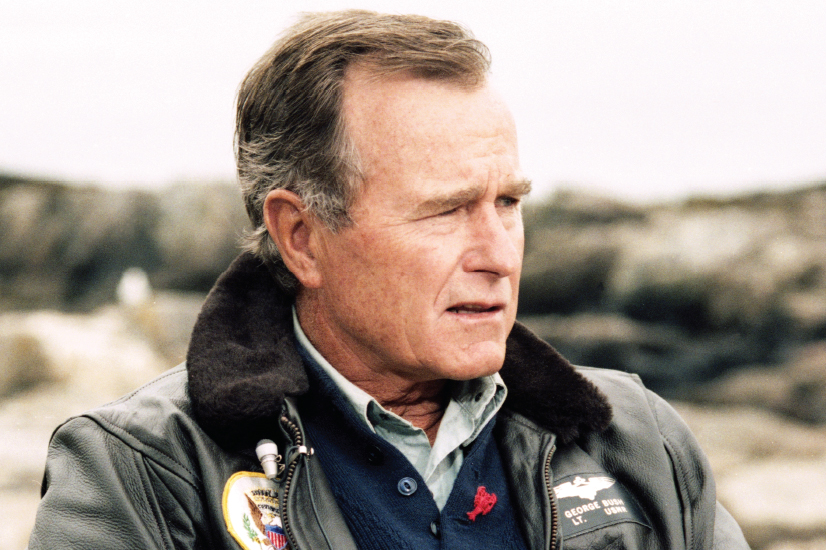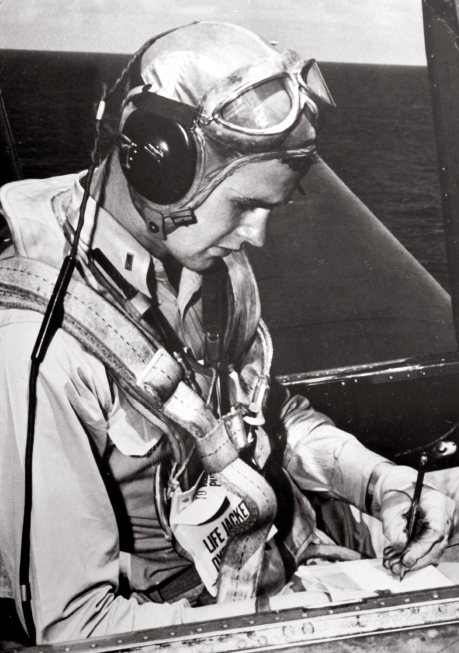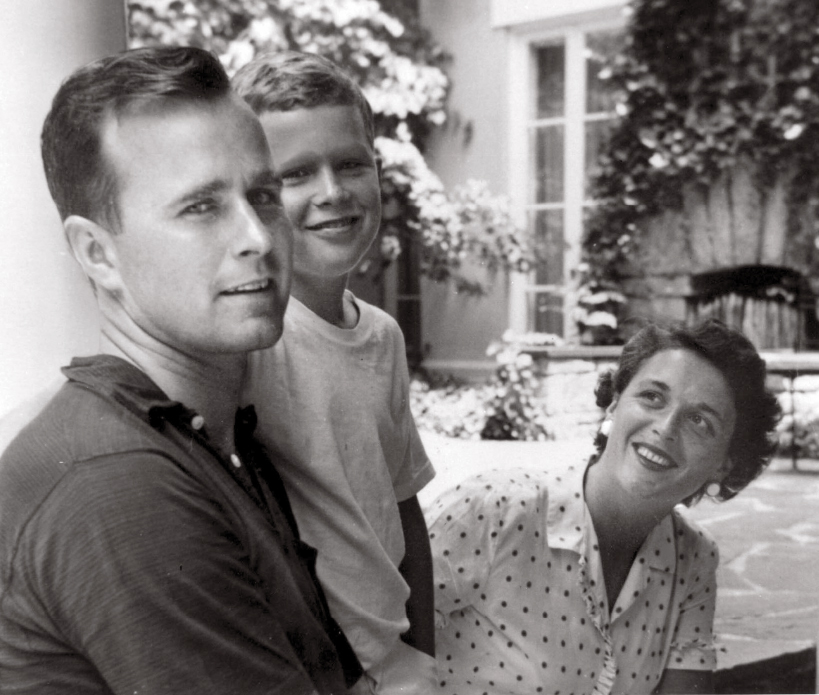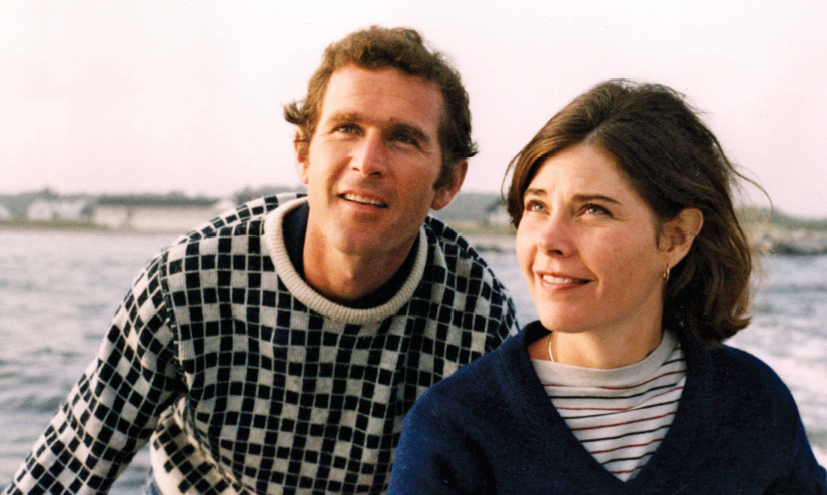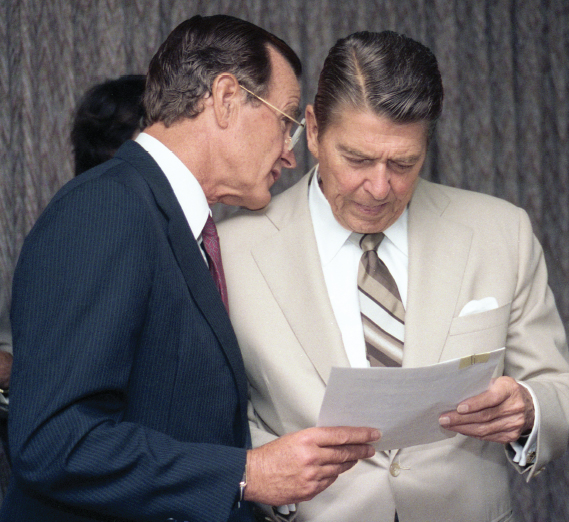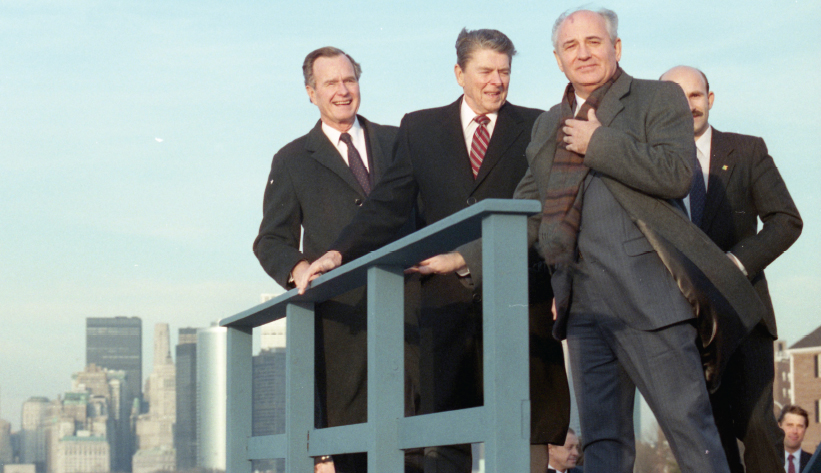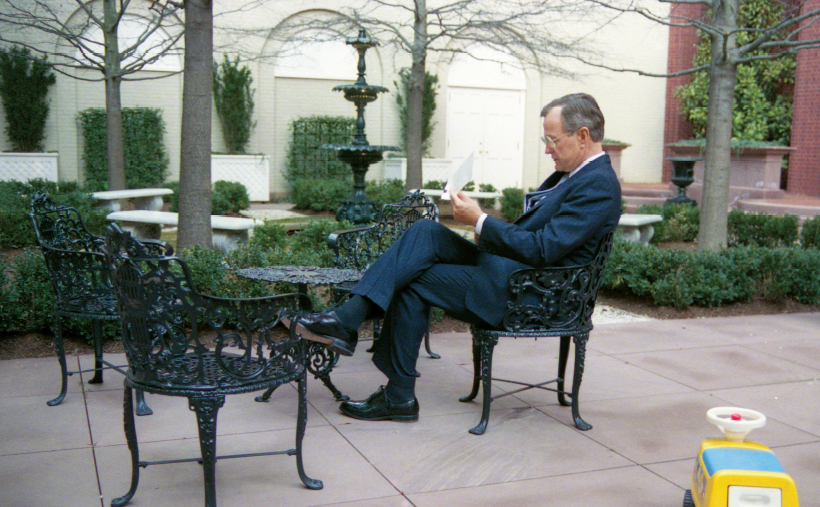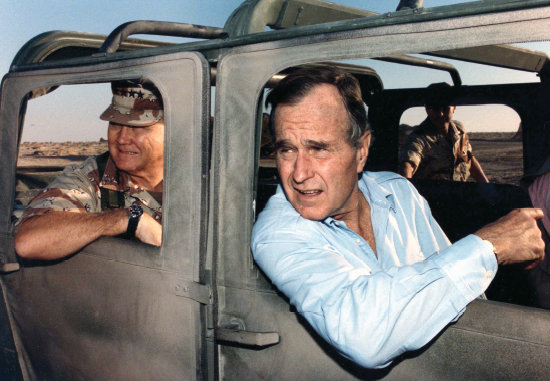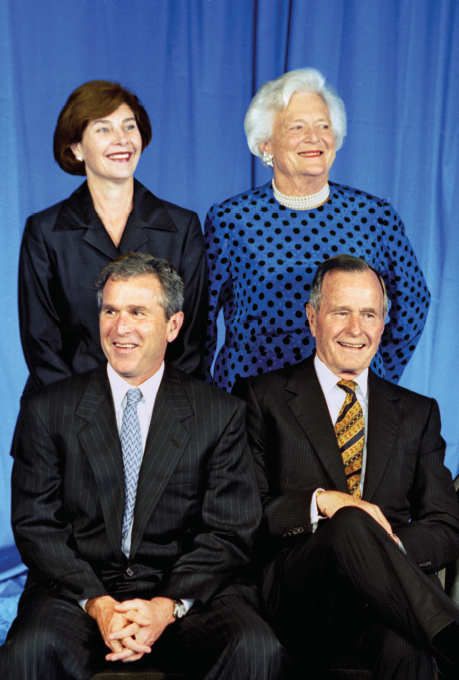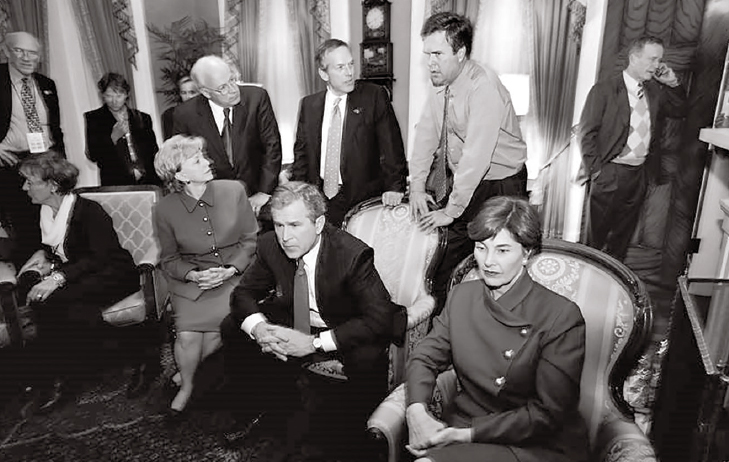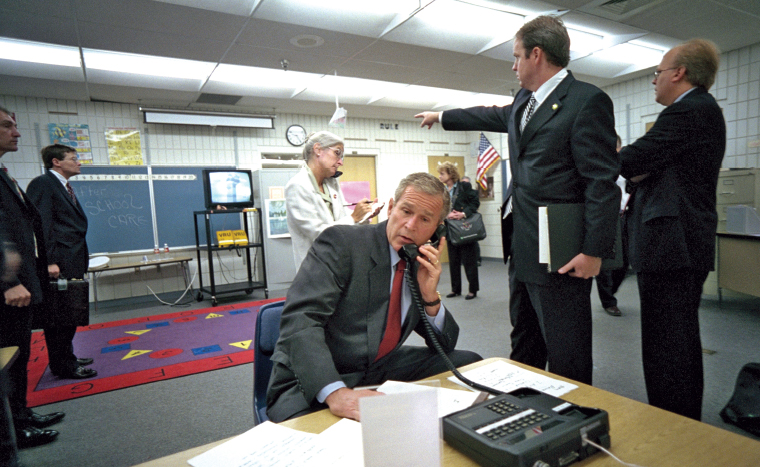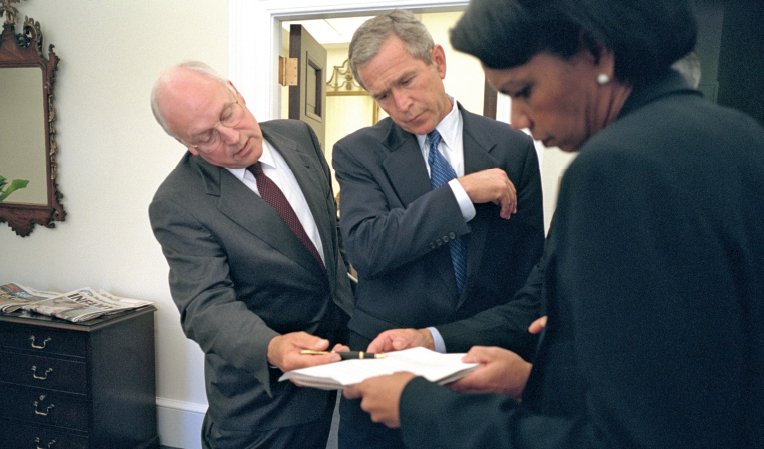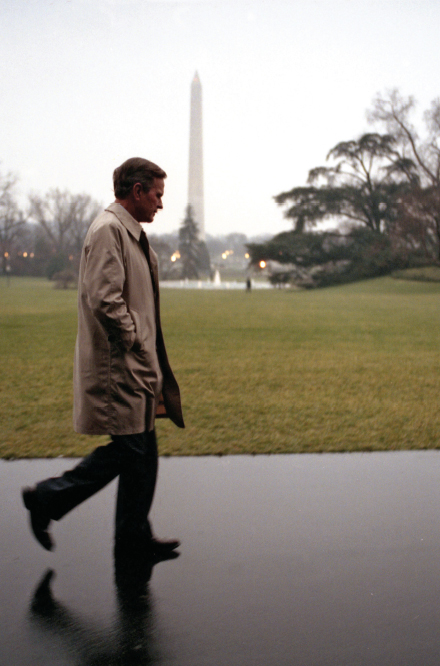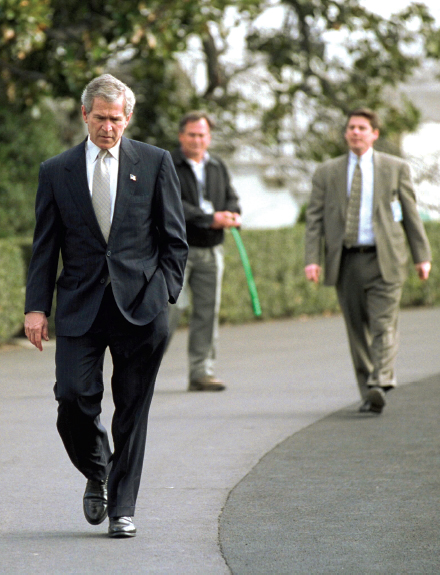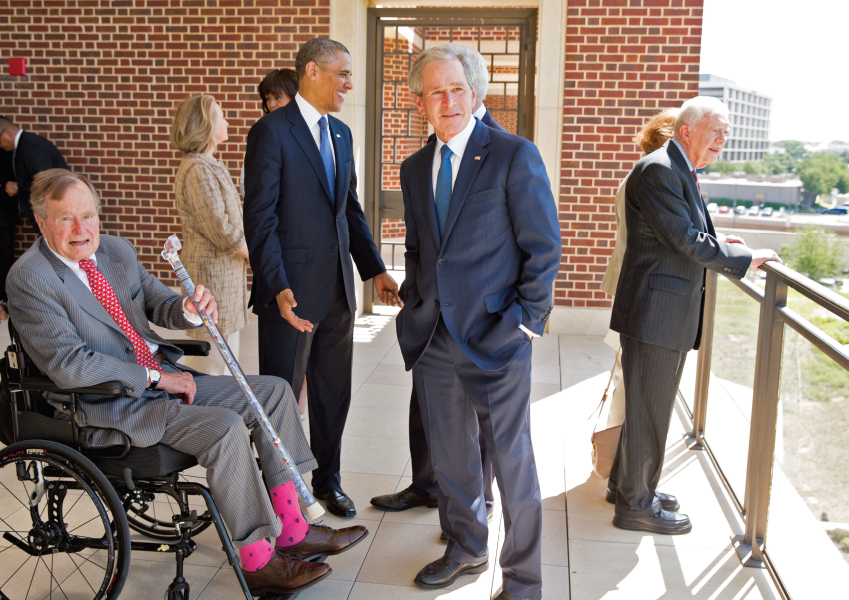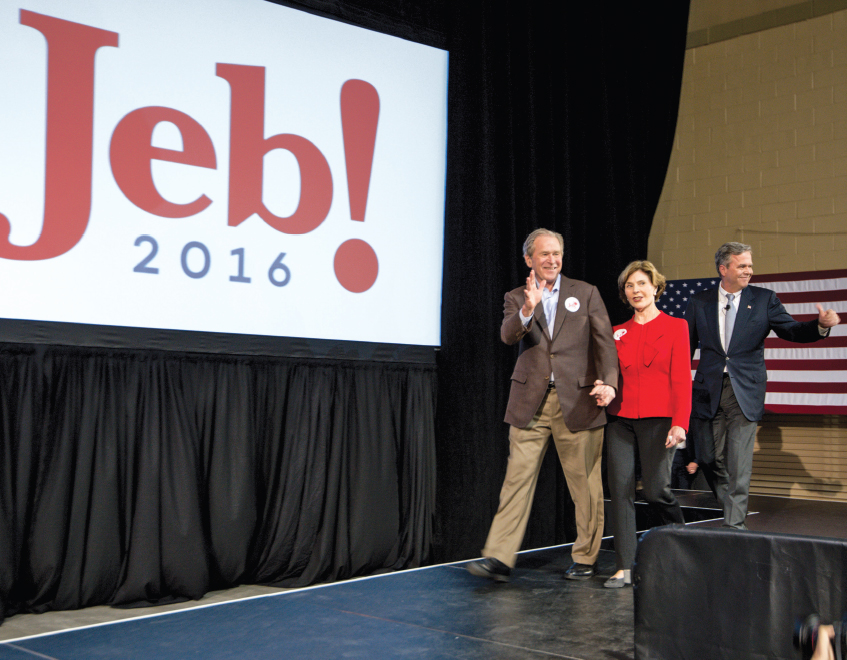PHOTOS SECTION
Defining portraits of the two Bush presidents: George Herbert Walker Bush, a blend of prim, patrician New England, where he was reared, and rough-and-tumble Texas, his adopted state, where he came into his own; and George Walker Bush, New Haven–born and Ivy League–educated, but a cultural product of his boyhood home, Midland, Texas, with his Lone Star swagger and unvarnished charm. (George Bush Presidential Library and Museum; George W. Bush Presidential Library and Museum)
George H. W. Bush, a child of Brahmin privilege, nicknamed “Little Pop” or “Poppy” for his namesake and paternal grandfather, George Herbert Walker, and “Have-half” for his natural generosity. (George Bush Presidential Library and Museum)
U.S. Navy pilot GHWB during World War II. Defying his father’s wishes, Bush enlisted in the Navy on his eighteenth birthday. When his torpedo bomber was shot down over the Pacific, Bush lost two crewmates, emerging as the plane’s lone survivor. “In my view, there’s got to be some kind of destiny,” he reflected later, “and I was being spared for something on earth.” (George Bush Presidential Library and Museum)
Barbara, George W., George, Dorothy, and Prescott Bush, Odessa, Texas, March 1949. George declined to take his father’s path to the riches of Wall Street, opting instead to make it on his own in the West Texas oil business. “And I never looked back,” he said. (George Bush Presidential Library and Museum)
George, George W., and Barbara, Rye, New York, 1955. “George [W.] aggravates the hell out of me at times,” wrote the elder Bush to his father-in-law the same year. “But then at times I am so proud of him I could die.” (George Bush Presidential Library and Museum)
The Bush family—Doro, George, Jeb, Marvin, George W., Neil, and Barbara—pose during George’s 1966 congressional campaign, as the boys imitate their father. Campaigning would become a Bush family affair. “Being in politics either brings you together or sends you apart,” Barbara said, “and in our case, it brought us all together.” (George Bush Presidential Library and Museum)
George W. and Laura Bush in the late 1970s. Married just four months after being introduced in 1977, they were, in Laura’s view, “two complementary souls.” Laura would play a vital supporting role for George W., just as Barbara played for George. (George Bush Presidential Library and Museum)
Vice President Bush and President Ronald Reagan at the 1984 GOP National Convention. Four years earlier, overcoming “strong reservations,” Reagan had tapped Bush to be his running mate, rescuing his former rival from almost-certain political obscurity. The two men went on to forge a close working relationship in the Reagan White House. (George Bush Presidential Library and Museum)
George W. Bush and his twin daughters, Barbara and Jenna, pose with Ruth and Billy Graham, Kennebunkport, Maine, summer 1983. Three years later, in a quest to be a better man, George W. would put heavy drinking behind him, and, inspired by Billy Graham’s spiritual mentorship, begin a “religious walk that still goes on today.” (George Bush Presidential Library and Museum)
Lee Atwater, George W., and Jeb with Vice President Bush on Election Day, Houston, Texas, November 8, 1988. George W. devoted a year to his father’s presidential campaign, becoming one of his key advisers, a sign that he had his father’s full faith and confidence. (George Bush Presidential Library and Museum)
Bush, Ronald Reagan, and Mikhail Gorbachev in New York with lower Manhattan in the background, a month before Bush’s inauguration, December 1988. Reagan would receive disproportionate credit when the Soviet Union collapsed the following year, but it was Bush as president who would help to ensure a peaceful end to the Cold War through his quiet diplomatic facility and inherent humility. (Ronald Reagan Presidential Library and Museum)
At Blair House on the morning of his inauguration, January 20, 1989, President-elect Bush reviews his speech, a reminder of one of his grandchildren to his left. Family was a balm for Bush during his presidency, lessoning its burden. (George Bush Presidential Library and Museum)
Bush meets with his advisers Brent Scowcroft, John Sununu, James Baker, and Dick Cheney after Iraq’s invasion of Kuwait under the order of Iraqi dictator Saddam Hussein, August 1990. Initially, Bush thought there was little that the United States could do before proclaiming that Saddam’s “naked aggression” against Kuwait “will not stand.” (George Bush Presidential Library and Museum)
Bush, with Norman Schwarzkopf, visiting U.S. troops in Saudi Arabia, November 1990. Reports of the atrocities inflicted on the Kuwaiti population by their Iraqi invaders made the Gulf War a moral imperative for Bush, who resolved to liberate Kuwait regardless of congressional approval. “If I don’t get the votes,” he told an aide, “I’m going to do it anyway. And if I get impeached, so be it.” (George Bush Presidential Library and Museum)
George P., Jeb’s oldest child; George; and George W. at Opening Day at Camden Yards, Baltimore, Maryland, April 1992. By then, George W., who had struggled to find business success, had helped engineer the purchase of the Texas Rangers and the building of a new state-of-the-art stadium, increasing his visibility in Texas and paving the road toward his political rise. (George Bush Presidential Library and Museum)
Bush and Bill Clinton, just prior to their third presidential debate, Michigan, October 1992. Clinton successfully reinforced public impressions that Bush was out of touch and lacked domestic vision. Bush would be devastated by his defeat at Clinton’s hands, convinced that Americans didn’t know his “heartbeat.” (George Bush Presidential Library and Museum)
George W. and Laura, the governor and first lady of Texas, pose with the elder Bushes at a celebration of the former President Bush’s seventy-fifth birthday. The political ambitions of George W. and Jeb gave George a sense of purpose in his post-presidency, helping him, from George W.’s perspective, “to recover” from his 1992 reelection loss. (George Bush Presidential Library and Museum)
Lynne and Dick Cheney, George W., Don Evans, Jeb, Laura, and George watch election returns at the Texas governor’s mansion in the early morning hours of November 8, 2000. The presidential election seesawed dramatically between Bush and his Democratic opponent, Al Gore, who conceded defeat to Bush before his retraction as polling results in Florida later proved inconclusive. It would take a U.S. Supreme Court decision thirty-six days later to proclaim Bush the election’s winner. (David Hume Kennerly)
Inaugurated earlier in the day as the forty-third president, George W. Bush greets his first Oval Office guest: the forty-first president. Trusting him to find his own way in the role, “41” refrained from proffering unsolicited presidential advice to “43.” “We had our chance,” was his view. “Now it’s his turn.” (George W. Bush Presidential Library and Museum)
On September 11, 2001, after learning that the second of the two World Trade Center towers has been struck by a plane, Bush gathers more information in a classroom at Emma E. Booker Elementary School in Sarasota, Florida, as White House Director of Communications Dan Bartlett points to television footage of the burning tower. The defining event of his presidency, 9/11 instantly made Bush a “wartime president,” something he “never wanted.” (George W. Bush Presidential Library and Museum)
Bush receives a briefing from Vice President Dick Cheney and Secretary of State Condoleezza Rice, at the White House, September 12, 2001. Cheney’s dominant neoconservative influence on foreign policy in Bush’s first term began to wane during Bush’s second term as the president began to rely more on Rice. (George W. Bush Presidential Library and Museum)
With manifest pride, George pats George W.’s arm after the latter’s speech at a post-9/11 National Day of Prayer and Remembrance at the National Cathedral in Washington, DC, September 14, 2001. The moment would be the most indelible memory each would hold of the other during 43’s eight-year presidency. (George W. Bush Presidential Library and Museum)
Later the same day, atop the rubble of the World Trade Center, President Bush rallies first responders in lower Manhattan, with retired firefighter Bob Beckwith at his side. During the visit, the mother of a missing Port Authority officer pressed her son’s police badge into Bush’s hand, which he carried throughout his presidency as “a reminder of all that was lost.” (George W. Bush Presidential Library and Museum)
Echoing his father’s resolve and solemn walk around the South Lawn after ordering Operation Desert Storm in 1991, 43 walks the White House grounds reflectively after giving the go-ahead to begin Operation Iraqi Freedom, his most fateful presidential decision, March 19, 2003. Immediately afterward, he wrote his father, “I know what you went through.” (George Bush Presidential Library and Museum; George W. Bush Presidential Library and Museum)
Peering out a window of Air Force One, President Bush surveys the destruction of Hurricane Katrina over New Orleans, creating the impression of detachment and indifference, August 2005. Striking as the War in Iraq was becoming increasingly unpopular, Katrina marked the low point of 43’s presidency. (George W. Bush Presidential Library and Museum)
Five presidents—Bush 41, Barack Obama, Bush 43, Bill Clinton (obscured by Bush 43), and Jimmy Carter—gather to inaugurate the George W. Bush Presidential Library, Dallas, Texas, April 13, 2013. Forty-one attended the gathering against all odds, after battling a near-fatal bout with pneumonia just several months earlier. Forty-three believed it was his father’s love for family that pulled him through. (George W. Bush Presidential Center)
George W. and Laura join Jeb Bush in a last-ditch effort to save Jeb’s 2016 presidential campaign, North Charleston, South Carolina, February 16, 2016. The Bush presidential dynasty was derailed after Jeb’s loss to his populist challenger Donald Trump, a “blowhard” in 41’s view, for whom neither 41 nor 43 voted. (George W. Bush Presidential Center)
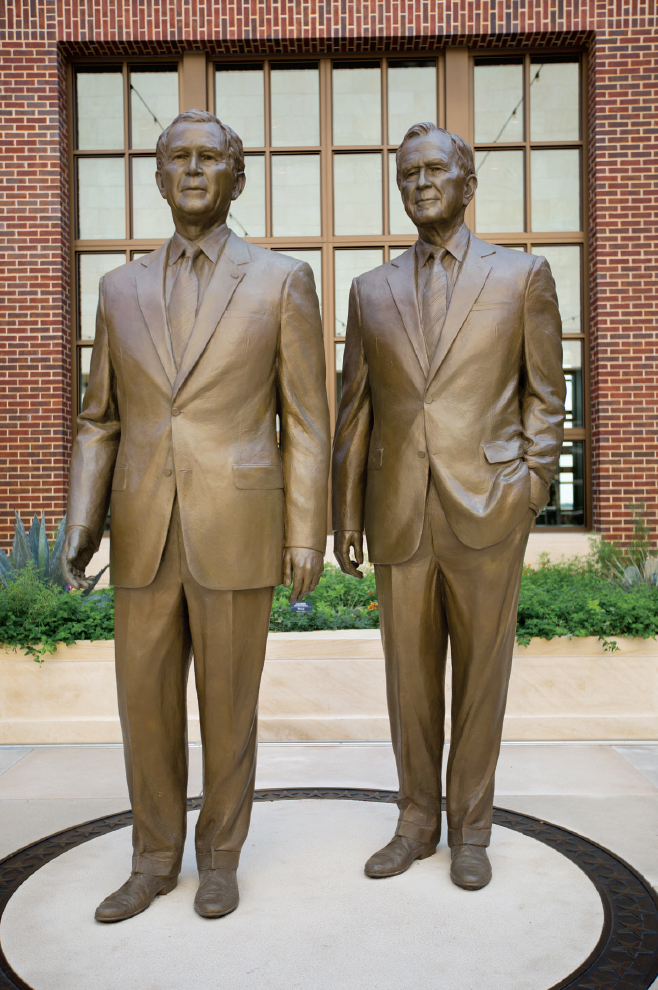
Statues of the Bush presidents—only the second father and son to hold the nation’s highest office—at the George W. Bush Presidential Library in Dallas. (George W. Bush Presidential Center)
